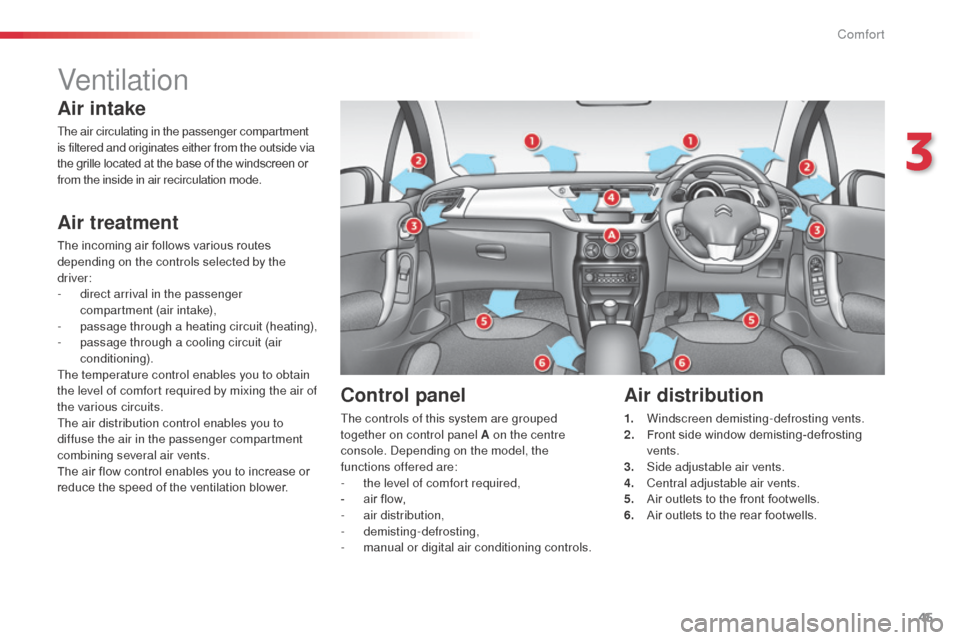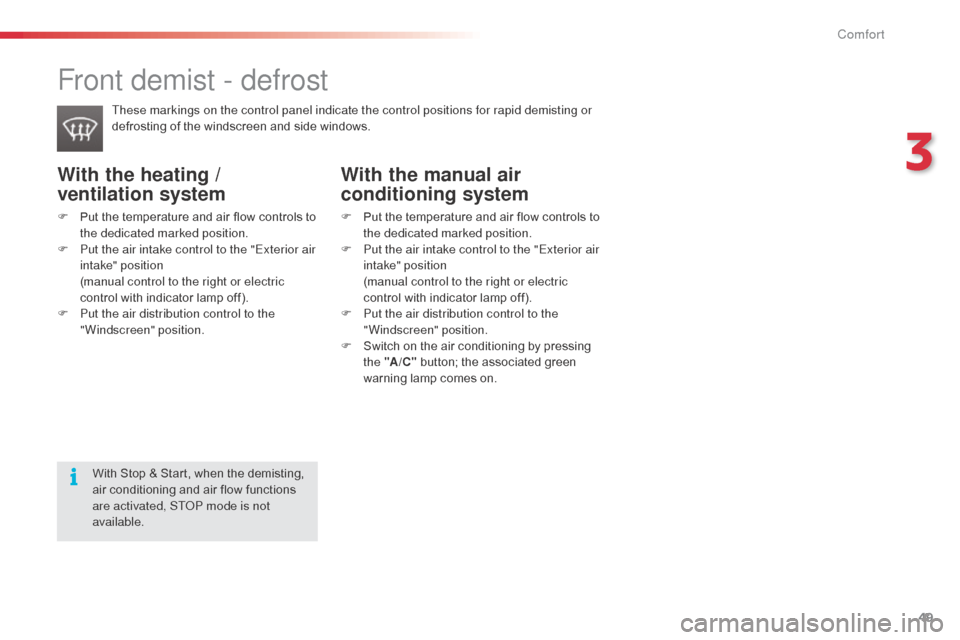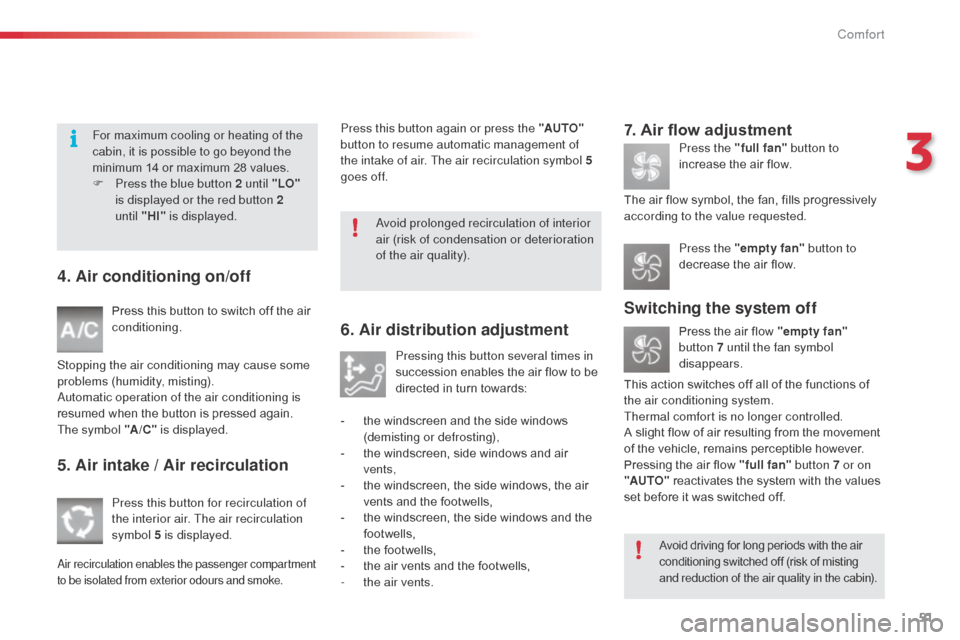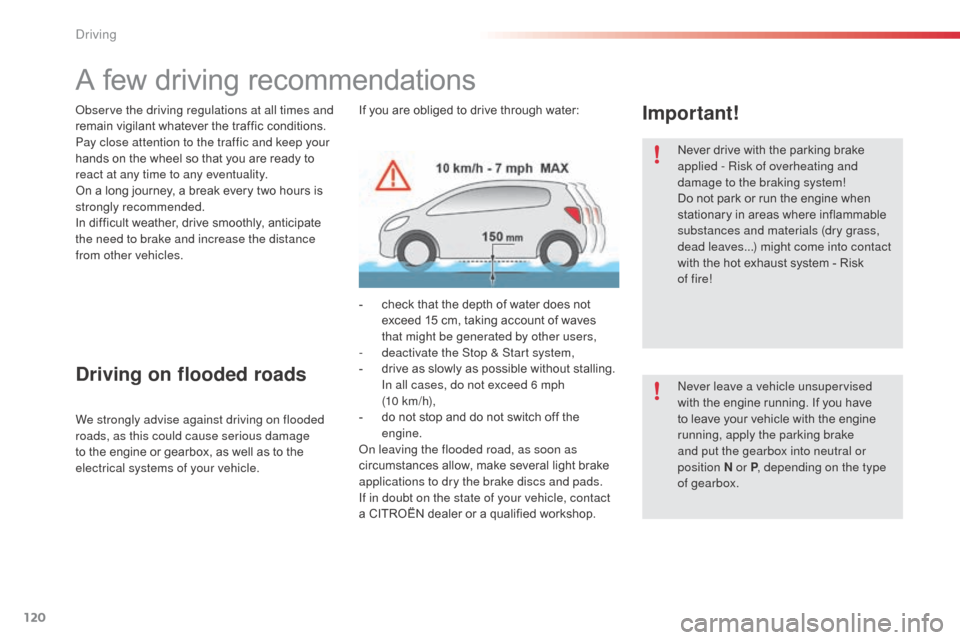heating Citroen C3 RHD 2015 2.G Owner's Manual
[x] Cancel search | Manufacturer: CITROEN, Model Year: 2015, Model line: C3 RHD, Model: Citroen C3 RHD 2015 2.GPages: 324, PDF Size: 9.86 MB
Page 4 of 324

.
.
Child seats 92
dea
ctivating the passenger’s front airbag
9
5
IS
oF
IX child seats
1
01
Electric child lock
1
05
Child safety
Instrument panels 1 0
Indicator and warning lamps
1
2
a
djustment buttons
2
8
Trip computer
3
0
MonitoringOver view
Monochrome screen A 3
4
Monochrome screen C
3
7
Touch screen tablet
4
0
Multifunction screens
Ventilation 45
Heating
4
7
Manual air conditioning
4
7
Front demist - defrost
4
9
di
gital air conditioning
5
0
Rear screen demist - defrost
52
Scented air freshener
5
3
Front seats
5
4
Rear seats
5
6
Mirrors
5
7
Steering wheel adjustment
5
8
a
udio pre-equipment
5
9
ac
cessories
61
Comfort
Remote control key 6 3
Alarm
6
7
Window controls
6
9
D o o r s
71
Boo
t
7
4
access
Lighting controls 75
LED daytime running lamps
7
9
Headlamp adjustment
7
9
Wiper controls
8
0
Courtesy lamps
8
3
Interior mood lighting
8
4
Boot lamp
8
4
Visibility
Interior fittings 8 5
Boot fittings
9
0
Fittings
Eco-driving
Contents
Page 15 of 324

13
Front foglampsfixed. The front foglamps are switched on
using the ring on the lighting control
stalk. Turn the ring on the lighting control stalk rear ward
twice to switch off the front foglamps.
Rear foglamps fixed. The rear foglamps are on. Turn the ring on the stalk rear ward to switch off the
rear foglamps.
Diesel engine
pre-heating fixed.
The key is at position 2 (ignition on) in
the ignition switch. Wait until the warning lamp goes off before starting.
The period of illumination of the warning lamp is
determined by the ambient conditions (up to about
thirty seconds in very low temperatures).
If the engine does not start, switch the ignition off and
then on, wait until the warning lamp goes off again,
then start the engine.
Parking brake fixed. The parking brake is applied or not
properly released. Release the parking brake to switch off the warning
lamp, keeping your foot on the brake pedal.
ob
serve the safety recommendations.
For more information on the parking brake, refer to the
corresponding section.
Dipped beam
headlamps
fixed.
The lighting stalk is in the "
di
pped
beam headlamps" position.
Main beam
headlamps fixed.
The lighting stalk is pulled towards
you. Pull the stalk to return to dipped beam headlamps.
Warning/indicator lamp
is onCause Action / Observations
1
Monitoring
Page 47 of 324

45
Ventilation
Air intake
The air circulating in the passenger compartment
is filtered and originates either from the outside via
the grille located at the base of the windscreen or
from the inside in air recirculation mode.
Air treatment
The incoming air follows various routes
depending on the controls selected by the
driver:
-
d
irect arrival in the passenger
compartment (air intake),
-
p
assage through a heating circuit (heating),
-
p
assage through a cooling circuit (air
conditioning).
The temperature control enables you to obtain
the level of comfort required by mixing the air of
the various circuits.
The air distribution control enables you to
diffuse the air in the passenger compartment
combining several air vents.
The air flow control enables you to increase or
reduce the speed of the ventilation blower.
Control panel
The controls of this system are grouped
together on control panel A on the centre
console.
d
e
pending on the model, the
functions offered are:
-
t
he level of comfort required,
-
a
ir flow,
-
a
ir distribution,
-
demisting-defrosting,
-
m
anual or digital air conditioning controls.
Air distribution
1. Windscreen demisting-defrosting vents.
2. Front side window demisting-defrosting
vents.
3.
S
ide adjustable air vents.
4.
C
entral adjustable air vents.
5.
A
ir outlets to the front footwells.
6.
A
ir outlets to the rear footwells.
3
Comfort
Page 49 of 324

47
Heating / VentilationManual air
conditioning
The heating / ventilation or air conditioning
systems operates with the engine running,
as well as in STOP mode with Stop & Start.
1. Temperature adjustment
2. Air flow adjustment
F Turn the dial from blue
(cold) to red (hot) to adjust
the temperature to your
requirements.
F
T
urn the dial from position 1
to position 5 to obtain a
comfortable air flow.
Manual control panel
Electric control panel Manual control panel
Electric control panel
F If you place the air flow control
in position 0 (deactivation of the
system), the temperature is no
longer maintained at a comfortable
level. However, a slight flow of air,
due to the movement of the vehicle,
can still be felt.
3
Comfort
Page 51 of 324

49
With the heating /
ventilation system
F Put the temperature and air flow controls to the dedicated marked position.
F
P
ut the air intake control to the "Exterior air
intake" position
(
manual control to the right or electric
control with indicator lamp off).
F
P
ut the air distribution control to the
"Windscreen" position.
Front demist - defrost
These markings on the control panel indicate the control positions for rapid demisting or
defrosting of the windscreen and side windows.
With the manual air
conditioning system
F Put the temperature and air flow controls to the dedicated marked position.
F
P
ut the air intake control to the "Exterior air
intake" position
(
manual control to the right or electric
control with indicator lamp off).
F
P
ut the air distribution control to the
"Windscreen" position.
F
S
witch on the air conditioning by pressing
the "A /C " button; the associated green
warning lamp comes on.
With Stop & Start, when the demisting,
air conditioning and air flow functions
are activated, ST
oP m
ode is not
available.
3
Comfort
Page 53 of 324

51
4. Air conditioning on/off
Press this button to switch off the air
conditioning.
Stopping the air conditioning may cause some
problems (humidity, misting).
au
tomatic operation of the air conditioning is
resumed when the button is pressed again.
The
symbol "A /C " is displayed.
5. Air intake / Air recirculation
Press this button for recirculation of
the interior air. The air recirculation
symbol 5 is displayed.
air recirculation enables the passenger compartment
to be isolated from exterior odours and smoke.
6. Air distribution adjustment
Pressing this button several times in
succession enables the air flow to be
directed in turn towards:
-
t
he windscreen and the side windows
(demisting or defrosting),
-
t
he windscreen, side windows and air
vents,
-
t
he windscreen, the side windows, the air
vents and the footwells,
-
t
he windscreen, the side windows and the
footwells,
-
t
he footwells,
-
t
he air vents and the footwells,
-
t
he air vents.
7. Air flow adjustment
Press the "full fan" button to
increase the air flow.
The air flow symbol, the fan, fills progressively
according to the value requested.
Switching the system off
Press the air flow "empty fan"
button 7 until the fan symbol
disappears.
This action switches off all of the functions of
the air conditioning system.
Thermal comfort is no longer controlled.
A
slight flow of air resulting from the movement
of the vehicle, remains perceptible however.
Pressing the air flow "full fan" button 7 or on
"AUTO" reactivates the system with the values
set before it was switched off. Press the "empty fan"
button to
decrease the air flow.
Press this button again or press the "AUTO"
button to resume automatic management of
the intake of air. The air recirculation symbol 5
goes off.
Avoid driving for long periods with the air
conditioning switched off (risk of misting
and reduction of the air quality in the cabin).
For maximum cooling or heating of the
cabin, it is possible to go beyond the
minimum 14 or maximum 28 values.
F
P
ress the blue button 2 until "LO"
is displayed or the red button 2
until
"HI" is displayed.
av
oid prolonged recirculation of interior
air (risk of condensation or deterioration
of the air quality).
3
Comfort
Page 54 of 324

52
Rear screen demist - defrost
Switching on
The rear screen demisting/defrosting can only
operate when the engine is running.
F
P
ress this button to demist /defrost the
rear screen and (depending on version)
the door mirrors. The indicator lamp
associated with the button comes on.
Switching off
The demisting/defrosting switches off
automatically to prevent an excessive
consumption of current.
F
I
t is possible to stop the demisting/
defrosting operation before it is switched
off automatically by pressing the button
again. The indicator lamp associated with
the button switches off.
The control button is located on the heating or air conditioning system control panel.
Switch off the demisting/defrosting
of the rear screen and door mirrors
as soon as appropriate, as reducing
electrical power consumption results in
reduced fuel consumption.
With Stop & Start, when demisting has
been activated, the ST
oP m
ode is not
available.
If the engine is switched off before the
demisting/defrosting is switched off
automatically, demisting/defrosting will
resume next time the engine is switched on.
Comfort
Page 61 of 324

59
audio pre-equipment
Your vehicle is equipped with certain factory-
fitted audio equipment:
-
a d
ual-function aerial at the rear of the roof,
-
a c
oaxial aerial cable,
-
b
asic interference suppression,
-
c
abling for speakers in the front doors and
tweeters in the dashboard,
-
c
abling for speakers in the rear doors
-
a 4
0 -way connector.
be
fore installing a radio unit or
speakers in your vehicle, you can
contact a CITROËN dealer who will
give you the part number for a suitable
wiring harness.Fitting an audio unit
F Unclip the storage box on each side using a screwdriver and pull out.
You will then have access to an aerial coaxial
cable and a 40 -way connector.
Then refer to the instructions provided with
your audio unit.
Fitting speakers
It is possible to fit:
- 1 65 mm diameter speakers in the front
doors,
-
1
30 mm diameter speakers in the rear
doors,
-
2
2.5 mm diameter tweeters in the top of the
dashboard.
The audio unit is fitted in place of one of the
storage boxes located below the heating and
air conditioning control panel.
3
Comfort
Page 122 of 324

120
A few driving recommendations
Never drive with the parking brake
applied - Risk of overheating and
damage to the braking system!
Do not park or run the engine when
stationary in areas where inflammable
substances and materials (dry grass,
dead leaves...) might come into contact
with the hot exhaust system - Risk
of fire!
ne
ver leave a vehicle unsupervised
with the engine running. If you have
to leave your vehicle with the engine
running, apply the parking brake
and put the gearbox into neutral or
position
N or P, depending on the type
of gearbox.
ob
serve the driving regulations at all times and
remain vigilant whatever the traffic conditions.
Pay close attention to the traffic and keep your
hands on the wheel so that you are ready to
react at any time to any eventuality.
On a long journey, a break every two hours is
strongly recommended.
In difficult weather, drive smoothly, anticipate
the need to brake and increase the distance
from other vehicles.
Driving on flooded roads
We strongly advise against driving on flooded
roads, as this could cause serious damage
to the engine or gearbox, as well as to the
electrical systems of your vehicle. -
c
heck that the depth of water does not
exceed 15 cm, taking account of waves
that might be generated by other users,
-
d
eactivate the Stop & Start system,
-
d
rive as slowly as possible without stalling.
In all cases, do not exceed 6 mph
(10 km/h),
- d o not stop and do not switch off the
engine.
on l
eaving the flooded road, as soon as
circumstances allow, make several light brake
applications to dry the brake discs and pads.
If in doubt on the state of your vehicle, contact
a CITROËN dealer or a qualified workshop. If you are obliged to drive through water:
Important!
driving
Page 124 of 324

122
Starting the engine
F apply the parking brake.
F W ith a manual gearbox: place the lever in
neutral and fully depress the clutch pedal.
F
W
ith an electronic gearbox: place the lever
at position N and press the brake pedal
f i r m l y.
F
W
ith an automatic gearbox: place the lever
at position P and press the brake pedal
f i r m l y.
F
I
nsert the key in the ignition switch; the
system recognises the code.
F
U
nlock the steering column by
simultaneously turning the steering and
t h e
key.
In some circumstances, you may have
to apply some force to turn the steering
wheel (wheels on lock for example).
F
W
ith a petrol engine, operate the starter
motor by turning the key to position 3 until
the engine starts, without pressing the
accelerator pedal.
o
n
ce the engine starts,
release the key. F
W ith a di esel engine, turn the key to
position 2 , ignition on, to operate the
engine preheating system.
Wait until this warning lamp goes off
in the instrument panel, then operate
the starter motor by turning the key to
position 3 until the engine starts, without
pressing the accelerator pedal.
o
n
ce
the engine starts, release the key.
If the engine does not start straight
away, switch the ignition off. Wait a
few moments before trying again. If
the engine does not start after a few
attempts, do not keep trying: you risk
damaging the starter motor and the
engine. Call on a CITR
oËn
dealer or a
qualified workshop.
ne
ver leave the engine running in
an enclosed area without adequate
ventilation: internal combustion
engines emit toxic exhaust gases,
such as carbon monoxide.
d
a
nger of
intoxication and death. In very severe
winter conditions (temperatures
below -23°C), it is necessary to allow
the engine to run for 4 minutes before
setting off, in order to ensure the
correct operation and durability of
the mechanical components of your
vehicle, the engine and gearbox.
In wintry conditions, the warning lamp
will stay on longer. When the engine is
hot, it does not come on. In temperate conditions, do not
warm the engine up with the vehicle
stationary, but move off straight away
and drive at moderate engine speeds.
Driving